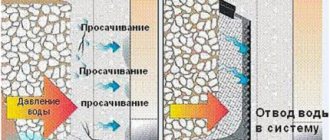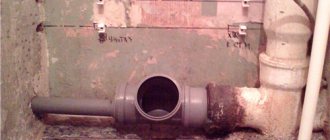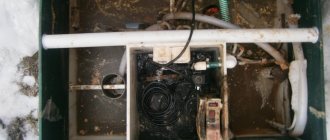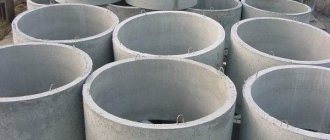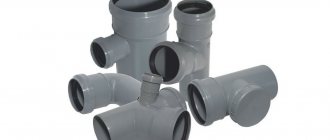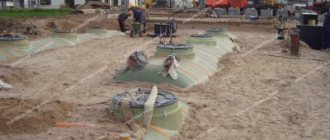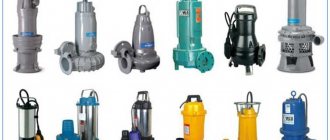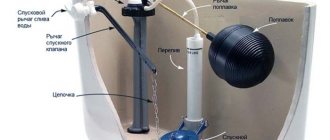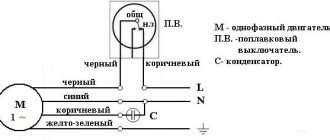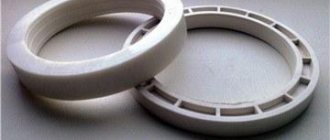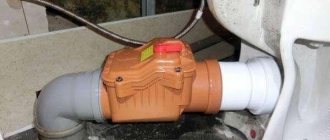Types of sewer wells
A structure of this kind has its own purpose and method of construction. Sewage tanks differ in a number of ways.
By functional purpose
There are several types of wells:
- Cumulative. This is a more modern and environmentally friendly option for a waste pit. It carries out fractionation of wastewater and sewage. Liquid and light particles are directed into the filtering septic tank, and heavy particles fall to the bottom of the storage tank. The volume of the structure is 2-50 thousand liters and depends on the amount of water used. It must be installed at the lowest point of the site, which ensures the correct angle of inclination of the sewer pipes.
- Filtering. The structure is designed to discharge wastewater into the soil. The well design has no bottom. The installation of filter collectors is allowed only on sandy and sandy-clayey soils. As a rule, wells are made of reinforced concrete rings. Sand, crushed stone and special materials can serve as a filter.
- Lookout. Used for periodic inspection and convenient cleaning of the drainage system in small areas where the direction, slope or diameter of pipes changes, in connection areas. Unlike other types of treatment facilities, presented in the form of a pipe or collection tank, the inspection tank is an open container. It is mounted in a straight line in increments of 15 meters, while the initial well is placed at a distance from the house no closer than 3 meters and no further than 12 meters.
- Turning. The structure is intended for areas with a branched drainage pipeline, as well as in cases where the angle of rotation on the pipeline exceeds 90 degrees. This is due to the lack of possibility of constructing a continuous straight section from a residential building to a storage septic tank. Rotary collectors must be erected at each bend of the laid pipe. This design can be used as an inspection septic tank, which makes it quite easy to clean a certain section of the pipeline through it.
- Perepadny. Used in areas with large elevation differences. In this case, the inlet pipe is placed much higher than the outlet pipe. The design of the septic tank has a drop, which is a vertical pipe going into the well, which is connected to the inlet. The lowering is attached to the tank wall using clamps. The length of this element depends on the difference in the area. On the reverse side of the lowering, a 45 degree bend is installed.
By materials used
Collectors are made from various materials:
- Reinforced concrete. The structures are durable, resistant to the negative effects of chemical compounds, and fairly easy to install. In addition, they have a large weight and different ring diameters. The products are used for constructing septic tanks of filtering, storage and inspection types. Suitable for installation in any type of soil.
- Brick. For the construction of the collector, clay waterproof bricks are often used. Brick can be used to build structures of square, rectangular or round shape.
- Plastic. Structures made of polyethylene are characterized by high strength, tightness, wear resistance, as well as ease of installation and relatively low cost. They are used for installing rotary, differential and inspection septic tanks.
Reinforced concrete structures are durable, resistant to the negative effects of chemical compounds, and fairly easy to install
Sealed cesspool
Sealed sewer well
It is possible to fully meet the requirements for sewer wells only by constructing a sealed sewer well . This method does not harm the environment; the volume of wastewater can be increased.
This method is recommended in areas with moderate wastewater output. For example, a family of 4 can produce about 600 liters of sewage per day, assuming 150 liters per person. Therefore, it is better to build a cesspool with a reserve in volume. It is worth remembering that its depth should not be more than 3 meters, otherwise the sewerage machine’s pipe will not reach the bottom.
The requirements and distances between objects according to SNIP for a sealed well are similar to the above requirements for a pit without a bottom.
The accumulated sewage is collected by a sewage disposal truck 1-2 times a month.
The construction of sealed sewer wells is possible using various materials.
The most popular today are:
- Reinforced concrete rings.
- Brick.
- Polymer tanks.
Advice: there are now many offers on the market from manufacturers of turnkey autonomous sewer systems. These are energy-dependent structures (with a pump) that save you time and site space. In addition, they will do all the work themselves. The downside is the high cost.
Rules and requirements
The process of planning and construction of sewer systems is carried out by Special Rules and Regulations (SNiP), regulating certain requirements, the main of which are:
- Structures should be located away from sources of drinking water and plumbing systems.
- Collectors should be installed at a distance from residential buildings and nearby areas.
- The volumes of the tanks must correspond to the number of people living in the house and the average volume of wastewater over a certain time period.
- The depth of the pit for the tank should not exceed 2.5 meters , and its diameter should be half a meter larger than the diameter of the structure.
- The need for waterproofing at high groundwater levels.
- The bottom of the pit must be covered with a sand cushion 10 cm high.
- A gap of 60 cm must be provided between the bottom of the tank and the bottom of the pipe
Collectors should be installed at a distance from residential buildings and nearby areas
Advantages and relevance of sewage tanks
The installation of sewer wells is necessary in dense urban areas, as well as on the territory of a country house. The reservoir plays the role of a collector, inspection device, storage tank or other technical element that provides easy access to the underground pipeline.
Sewage well placement diagram
If there is a well, in the event of a failure of the water drainage system, there is no need to dig up and replace all the pipes - it is enough to carry out an inspection of the failed area. Therefore, the installation of sewer wells has undeniable relevance and justified advantages. The main advantages of using concrete structures include:
- ease of installation;
- high reliability;
- waterproof;
- resistance to aggressive environments;
- long service life.
Installation diagram of sewer wells made of concrete rings
Construction of a sewer well
Preparatory work
Preparation for the construction of sewer septic tanks consists of several stages:
- drawing up a drawing of a sewerage diagram with marking of the installation location of the collector, layout of the site;
- cleaning the construction site;
- organization of a temporary road for equipment at the construction site;
- digging a pit and trench;
- cleaning and leveling the bottom of the pit.
Sewage well design diagram
Installation of a concrete well
Sewage wells made of concrete and brick practically do not differ in the stages and progress of installation work. In any case, installation proceeds as follows:
- A pit of the required size is dug.
- The foundation is being laid - pouring the foundation or a finished slab.
- Construction of walls - pouring or installing rings.
- Waterproofing walls and seams.
- Backfilling and compaction.
- Cover device.
In order to lower the finished rings into the pit, you will need to use special equipment.
Construction of a stone well
The construction of a septic tank from reinforced concrete rings is carried out as follows:
- After installing the first ring, holes are made in its walls for pipes, which should be inserted into the ring no more than 10 cm
Soil is excavated from the internal contour to level the structure horizontally. To eliminate errors in operation, this process should be controlled using a level.
- After installing the first ring, holes are made in its walls for pipes , which should be inserted into the ring no more than 10 cm. The hole is sealed around the circumference of the pipes with a solution.
- At the bottom of the tank there is a concrete trench located from the pipe inlet to the outlet. The cross-section of the gutter must be equal to the diameter of the pipes. To make it, you can take part of a sewer pipe.
- After installing the first ring, install the next one. At this stage, it is necessary to ensure that the locks on the inside of the rings are located at the same level.
- Upon completion of the installation of the last ring, the bottom of the collector is filled with concrete mortar , and the junctions of the rings are sealed with a sand-cement mixture. When constructing a filtering septic tank, its bottom is not concreted, but covered with 0.5 m thick crushed stone or crushed brick.
- Next, the structure is covered with a concrete slab with a hatch. You can also install a frame with a hole and fill it with concrete.
- After installing the well, they begin laying the pipeline at a depth of 60-70 cm with a slope of 2 cm through each meter of the pipeline.
- The next step is to test the design for 24 hours. To do this, the collector is filled with water, and the ends of the pipes are closed with plugs.
- After testing, the outer walls of the tank are covered with earth and thoroughly compacted.
- The final stage is to make a concrete blind area around the neck 1.5 meters wide.
Let's consider the technology of building a brick collector:
- A pit is dug, at the bottom of which formwork is installed and filled with a solution of cement, sand and crushed stone 20 cm high.
- Allow the solution to harden for 7 days , while periodically sprinkling with water.
- After the mortar has hardened, they begin laying brick walls using a cement mixture.
- The erected walls are plastered with sand-cement mortar.
- Without waiting for the solution to completely harden , iron the surface by rubbing a thin layer of dry cement into the plaster.
- The bottom of the collector is formed depending on its purpose.
- Waterproofing of the plastered layer is carried out.
- Cover the internal walls of the septic tank with mastic or bitumen.
- Form holes for pipes.
- The pipes are installed, and the resulting gaps are sealed with sealant.
- Fill the space between the pit and the walls of the well with soil and compact it thoroughly.
- Cover the collector with a hatch.
The construction of a well from natural stone is carried out according to a similar scheme. Difficulties in the process of its construction arise due to the unequal size and shape of the stones. Therefore, arranging the collector requires much more time and solution consumption.
Construction of an inspection drainage well
Disadvantages of different materials
Sewage tanks can be made of prefabricated reinforced concrete or monolith, as well as brick, polypropylene (PP) or polyvinyl chloride (PVC). The disadvantages of different materials include:
- the large mass of the well made of concrete rings, which implies the need to rent equipment for installation and delivery;
- the cost of hiring specialists to build a brick container, its proper sealing and waterproofing;
- risk of cracking of plastic tanks as a result of uneven loads.
Sewage well installation diagram
Related video: Construction of a sewer drainage well
Publications on the topic
Manufacturing a septic tank from reinforced concrete rings
Selection and installation of reinforced concrete rings for sewerage
Types of manholes for sewer wells
Features of well construction
When building a septic tank, it is important to take into account the installation features of each, depending on their purpose and material of manufacture.
The peculiarity of a filter well is that its main task is to clean wastewater from harmful impurities. To accomplish this task, the bottom of the collector is covered with crushed stone about 1 meter high. In this case, the bottom is not completely filled with concrete solution, but only along the perimeter. This prevents the destruction of the base and the release of water through the center of the circle in which drainage and cleaning occur.
For the construction of an inspection well, it is customary to use a pipe with a diameter of 46 cm. This pipe size makes it possible, if necessary, to clean the structure with water using a hose. If you need to go down into the tank, the diameter of the pipe must exceed 92.5 cm.
When constructing an inspection collector on an area without a road surface, an additional blind area is required, which facilitates the drainage of wastewater. If the road surface is of high quality, installation is carried out 7 cm above the ground surface.
Storage tanks are installed in the lowlands of the site to ensure water flows into the well. The structure is placed at a depth of 3-6.5 meters, no more than 7 rings are used during construction. At the bottom, special depressions are made, which are filled with sand or crushed stone. Water from the reservoir can be used for domestic needs.
Septic tank with filter well
Engineering communications of a private house
This option is already an engineering structure where the wastewater undergoes real treatment and is then drained into the soil. The level of wastewater purification (clarification) is up to 80% .
The principle of operation of this design is as follows: wastewater from the home enters the septic tank - a sealed sewer well. Here, solid particles settle to the bottom, and clarified water flows into a drainage well, where it is further purified and released into the ground.
In order to improve the quality of cleaning, you can use 2-3 drainage wells (sewage well series).
Septic tank and 2 drainage wells
You build a septic tank with your own hands according to the principle of a sealed drainage pit (see above). A drainage well is built according to the same principle, only without a bottom and not sealed. Moreover, the lower edge of the walls of the drainage well is made with perforation for better drainage of water into the ground.
Example of a septic tank with a drainage well
We dig a hole under the drainage well with a depth reserve of 40 cm. We put 20 cm of sand on the bottom, and 20 cm of gravel on it. This is an additional filter structure. We make the walls of the well perforated about a meter from the bottom. We also sprinkle the outer wall of the perforated well with 20 cm of gravel to prevent the holes from clogging with soil.
SNIP regulates such sewer wells in the same way as drainage pits. All distances are the same.
Blitz tips
- It is not recommended to make the trench depth too large , because you will need to add soil, which will subside over time. As a result, the highway may change the correct slope.
- To avoid damage to the pipeline, it is prohibited to place solid objects under the pipes during their installation .
- When choosing a site for the construction of a filtration or storage collector, it is necessary to provide for the possibility of equipment access to clean the structure.
- Despite the fact that a sewer septic tank is a wet type of well, its tightness must be ensured. This is necessary in order to minimize the penetration of wastewater into the environment. To waterproof the ring joint areas, special waterproof compounds are used.
- During the period of providing a waterproofing layer for 3 days, it is necessary to exclude the impact of mechanical loads and low temperatures on the surface. During this time, the treated areas should be regularly moistened using a regular sprayer. You can also cover the surface with a film, which helps reduce moisture evaporation.
How can you disguise a well?
No less interesting is the question of how to disguise wells. After all, the place for them is not chosen for reasons of beauty, but you want the appearance of the summer cottage not to be damaged. It may turn out that it just ruins the whole look. But finding a way out is not so difficult - you just need to decorate it. However, one condition must be observed.
When decorating a well, you should always leave access to it. That is, it is necessary to use removable decorative items, and it is also important to leave the ventilation pipe and ventilation hatch free. There are several ways to decorate:
- It can be covered with ornamental shrubs.
- Removable flower beds that can be easily removed at any time look good.
- You can install a light wire frame on top of the well and decorate it with climbing plants.
- You can put artificial stone on top. Natural boulders cannot be used due to their enormous weight.
We hope that the article answered all your basic questions about installing various types of sewer wells, and now you can do all the work yourself.
Materials for arranging a sewer shaft
Plastic materials are very popular. Such shafts have important advantages, including the reliability of the structure, its durability, as well as easy installation work.
According to its technical characteristics, plastic has the following advantages:
- High margin of safety and resistance to critical loads;
- Increased wear resistance;
- Smooth surface of the pipes, preventing the formation of build-up;
- Possibility of obtaining perfect tightness at the joints of parts.
An important disadvantage of plastic systems is considered to be used only in cases where the load on the sewer system is minimal. In addition, plastic is not suitable for installing a well in soft or constantly moving soil.
Concrete is not giving up its position either. This material, despite the difficulties during installation, is used everywhere.
Among the advantages of concrete structures it is worth noting:
- Possibility of use in any type of soil;
- Quick installation of rings;
- High margin of safety and reliability;
- Unaffected by chemicals.
The disadvantages are the large weight of the structures, which requires the use of special equipment, as well as the need to equip a tray in the sewer well for each structure.
1. Well made of reinforced concrete elements
SNiP, which regulates the creation of sewer networks, including wells on them, was written at a time when large structures made of polymers, and even high strength ones, were not even thought of.
Sewage cleaning was also carried out exclusively by hand - which is where the guys appeared in the hatches.
Their task was to push the clearing wire towards the blockage, while assistants above rotated its other end.
In order for a person to get down inside and work, the following standards were provided: the minimum size of the well was allowed to be 700 mm.
Next, sewer wells continued in a series of standard sizes: 1000, 1250, 1500, 2000 mm. In which standards they are still produced.
Round slabs are also produced in the same size - base and ceiling with a hole for a hatch (diameter 700 mm).
As a result, a standard reinforced concrete well consists of the following elements:
- Round or rectangular base
- Rings
- Ceiling with a hole for a hatch
- Manhole cover (cast iron, recently sometimes polymer)
The circular plan shape was adopted as it optimally resists the pressure of the surrounding soil.
Standard and additional reinforced concrete rings
Since it is impossible to predict in advance the place of use, both rings and base plates are produced absolutely flat, only with embedded parts (hinges) for installation.
During installation, you have to punch holes in the lower ring where the pipelines enter, and on the slab you have to make a tray of the appropriate shape from concrete or cement.
This design is used in manholes of all types, and in differential wells - with the installation of structures corresponding to the type.
The height of the well is gained through several rings - standard and additional. Before installing the next ring, you have to remove the mounting loops of the previous one.
In this case, all structural elements, including the base and ceiling, as well as pipeline inlets, are sealed with cement.
It is clear that the waterproofing of sewer wells constructed in this way leaves much to be desired.
The result: wastewater pollutes the ground, and groundwater contributes to sewer overflow.
Part 1. Classification of wells
Each structure of this kind has its own purpose and method of constructing a sewer well. They can be classified according to several criteria.
There are the following types of sewer wells:
- By network - wells can be installed on any drainage networks:
- Domestic and industrial wastewater
- Drainage
- Stormwater
- According to the material of manufacture:
- Concrete
- Brick
- Polymer
- By purpose:
- Variable
- Observations:
- With change in flow direction: Rotary
- Nodal
- Linear
Naturally, the most important characteristic is what functions the sewer well performs.
A differential well differs from a viewing well in that it is designed to change certain physical characteristics of the water flow.
Inspection cameras are designed to perform certain actions on the pipeline.
Locations depending on destination
The installation of inspection cameras is regulated by construction documents. According to SNiP, inspection points are installed in places of turns, as well as slopes when changing the linear pipeline. And at the junction of the central line of additional branches.
The removal of sewer systems for residents of the private sector is possible with the installation of inspection cameras. The diameter of the installed pipe is directly affected by the distance of its installation (linear section).
For pipeline lengths up to 35 meters, elements with a diameter of 150 mm are used. There is an inverse relationship. For example, if the diameter of the pipes included in the overall pipeline system is 150 meters, then, according to the installation conditions, there must be an inspection well after 35 meters. An industrial control system may be fundamentally different from its counterparts installed in the private sector.
